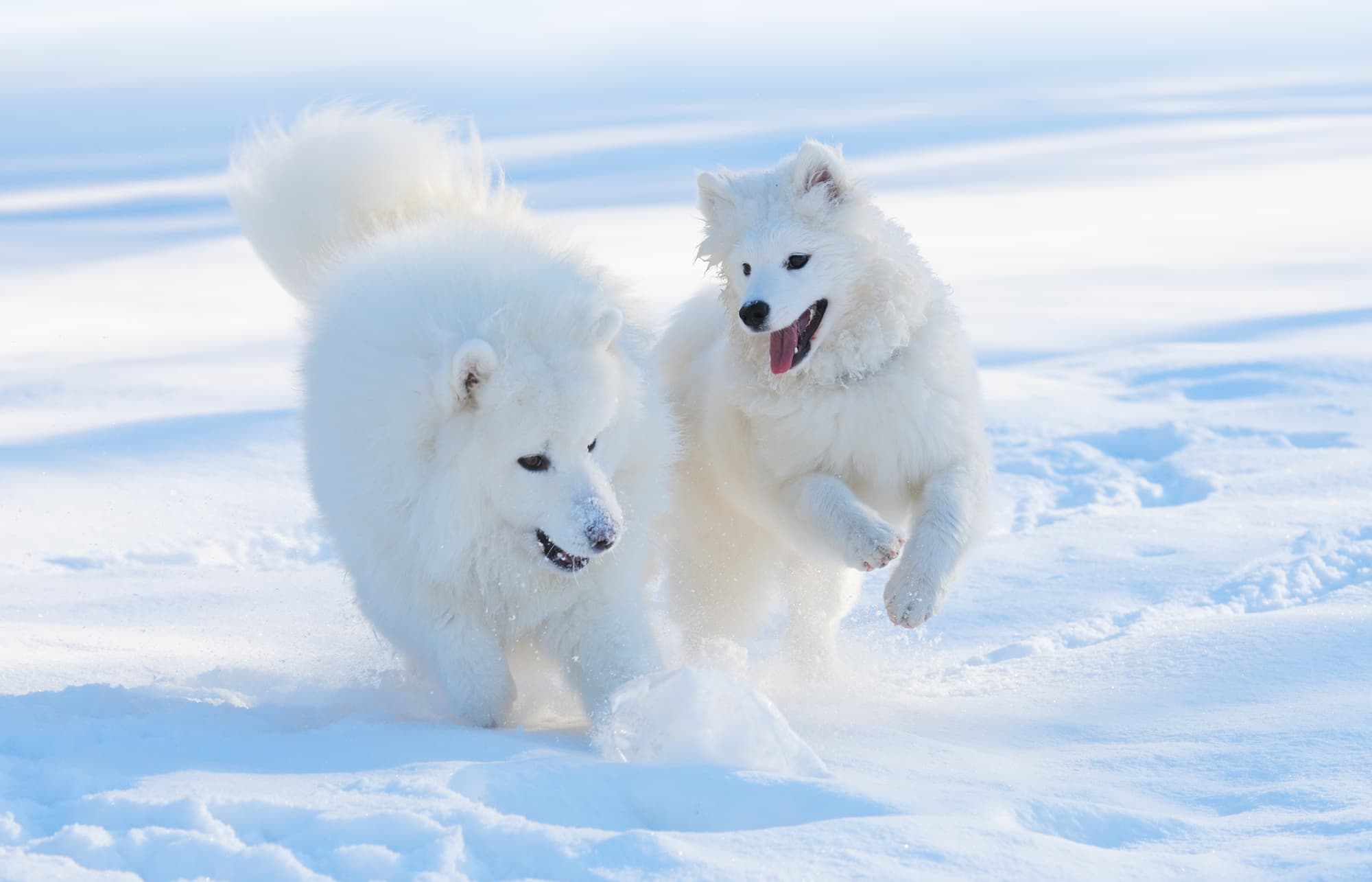Explorers such as Fridtjof Nansen and Robert Scott took Samoyeds on their expeditions to the North and South Poles. Early explorers didn’t fully understand the breed and cropped their distinctive tails. When sleeping, Samoyeds curl their tail over their face to keep their noses warm. Without the ability to do this, many Samoyeds died on cold-weather expeditions. The first Samoyed to live in England, however, had a happier life. Antarctic Buck was given to Queen Alexandra as a gift. The Queen became a Samoyed enthusiast and many of the Samoyeds in the UK and the States today can trace their lineage back to Queen Alexandra’s kennels.

Samoyed
The Samoyed, or “Smiling Sammie”, combines function with beauty in a compact frame that’s covered in a distinctive all-white or biscuit coat.
Country of Origin
Russia
Breed Group
Spitz
Height
Male 21-23 In
Female 19-21 In
Weight
Male 50-65 Ib
Female 35-50 Ib
Life Span
12-14 years
In a Nutshell
The dog’s nickname comes from the perpetual smile this breed appears to wear. Their smile is actually iconic: their black gums stark against their white fur, turned up in a happy little grin 24-7. But Samoyeds don’t smile because it’s cute – they do it because of evolution. They upturned mouth prevents the Samoyeds from drooling out of the corner of their mouths, which ultimately prevents drool icicles from forming in the frigid temperatures of their homeland.
Personable and intelligent, Samoyeds thrive on human companionship and do not do well when left alone for extended periods. Give a Samoyed love, attention, plenty of exercise, and a firm hand in training and they’ll reward you with entertaining devotion. A well-trained and socialized Sammie is gentle and friendly, almost too friendly to be a guard dog. They’ll welcome anyone into your home! As the Samoyed’s instinct is to herd and hunt, they do have a tendency to round up small children and cats. Raise them together, though, and you should have no problem.
Life With a Samoyed
Looks & Personality

The Samoyed is compact and muscular with a broad wedge-shaped head and muzzle that tapers to a black, liver, or brown nose. The corners of the lips curl up to give the characteristic “Sammie smile.” Samoyeds should have nice dark pigment around the eyes, nose, and lips despite the white coat color. A Sammie’s ears are erect and slightly rounded while the long tail is hair-covered and curls up over the dog’s back creating a distinctive silhouette. The Samoyed’s outstanding feature is its profuse double-layered coat. A soft, short undercoat is covered with harsh longer hairs that stand straight out from the body.
Sammies were bred for hard work in some of the world’s coldest regions and their beautiful coat is designed to protect them from these temperature extremes. It is a coat, however, that sheds a fair bit, especially during their twice-yearly molt. Daily brushing is an essential chore if you own a Samoyed while the ability to turn a blind eye to hairs on the sofa is a must. On the plus side, these dogs are virtually odorless. Bathing is rarely required.
In personality, Samoyeds are friendly, intelligent, and independent. As Siberian working dogs, they’re used to living in close proximity to nomad travelers, hence their love of human companionship. They’re always up for a cuddle. Leave them alone for too long and they will become unhappy dogs and nuisance barkers. Samoyeds tend to get along well with other dogs as well as people and with other pets they are raised with. They are herding dogs and may show some tendency to chase or nip. In general, they get along well with children, although they can be a little boisterous for small toddlers. On hot days, Sammies will seek out cool spots. This may include digging up your favorite flower bed.
A tip from a vet
A tip from a trainer
What about your Samoyed?
Did You Know

Samoyeds sure do shed a lot, but you can use their discarded fur to knit hats, scarves, or socks. Many say it has a similar texture to angora wool.

Because of their unique double coats, Samoyeds don’t have a lot of dander. The low amount of dander in their coat means that they don’t have the traditional doggy odor.

As well as having a lovely smile, Samoyeds are good at singing. Their genetic closeness to wolves gives them the ability to howl. They do this in quite a melodious way!
In The News
Famous Samoyed Owners
The History Behind the Breed
The Samoyed is truly an ancient breed, selected by nomadic tribes in Siberia to herd their reindeer and double as sled pullers when needed. Originally, these all-purpose dogs were of a variety of colors, but the sparkling white has since taken over in most areas of the world. The Samoyede people lived in tents and huddled for warmth with their dog packs during the Arctic nights. This type of human-canine cooperation for mutual survival forged a tight bond between Samoyed dogs and people.
In the late 18th century, Arctic explorers returning to England introduced the Samoyed to British dog lovers. Queen Alexandra was an admirer who did much to promote the breed as a companion and show dog. In America, a sparkling white dog named Moustan of Argenteau made history in 1906 as the first of the breed (then known as the Samoyede) registered by the AKC.
If a Samoyed Could Talk…
A Quick Anatomy Lesson


While the Samoyed can live a long life—up to about 14 years—they can be genetically predisposed to several medical issues, including eye and heart problems, hip dysplasia, and kidney disease. Their sensitivity to warmer temperatures can lead to other medical issues.
Common Health Problems
What about your Samoyed?
















